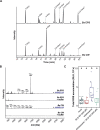Fungi hijack a ubiquitous plant apoplastic endoglucanase to release a ROS scavenging β-glucan decasaccharide to subvert immune responses
- PMID: 35441693
- PMCID: PMC9252488
- DOI: 10.1093/plcell/koac114
Fungi hijack a ubiquitous plant apoplastic endoglucanase to release a ROS scavenging β-glucan decasaccharide to subvert immune responses
Abstract
Plant pathogenic and beneficial fungi have evolved several strategies to evade immunity and cope with host-derived hydrolytic enzymes and oxidative stress in the apoplast, the extracellular space of plant tissues. Fungal hyphae are surrounded by an inner insoluble cell wall layer and an outer soluble extracellular polysaccharide (EPS) matrix. Here, we show by proteomics and glycomics that these two layers have distinct protein and carbohydrate signatures, and hence likely have different biological functions. The barley (Hordeum vulgare) β-1,3-endoglucanase HvBGLUII, which belongs to the widely distributed apoplastic glycoside hydrolase 17 family (GH17), releases a conserved β-1,3;1,6-glucan decasaccharide (β-GD) from the EPS matrices of fungi with different lifestyles and taxonomic positions. This low molecular weight β-GD does not activate plant immunity, is resilient to further enzymatic hydrolysis by β-1,3-endoglucanases due to the presence of three β-1,6-linked glucose branches and can scavenge reactive oxygen species. Exogenous application of β-GD leads to enhanced fungal colonization in barley, confirming its role in the fungal counter-defensive strategy to subvert host immunity. Our data highlight the hitherto undescribed capacity of this often-overlooked EPS matrix from plant-associated fungi to act as an outer protective barrier important for fungal accommodation within the hostile environment at the apoplastic plant-microbe interface.
� The Author(s) 2022. Published by Oxford University Press on behalf of American Society of Plant Biologists.
Figures






Comment in
-
Sweet talk: A plant protein releases a fungal β-glucan to enhance colonization.Plant Cell. 2022 Jul 4;34(7):2584-2585. doi: 10.1093/plcell/koac115. Plant Cell. 2022. PMID: 35536542 Free PMC article. No abstract available.
References
-
- Adams EL, Rice PJ, Graves B, Ensley HE, Yu H, Brown GD, Gordon S, Monteiro MA, Papp-Szabo E, Lowman DW, et al. (2008) Differential high-affinity interaction of dectin-1 with natural or synthetic glucans is dependent upon primary structure and is influenced by polymer chain length and side-chain branching. J Pharmacol Exp Therap 325: 115–123 - PubMed
-
- Benaroudj N, Lee DH, Goldberg AL (2001) Trehalose accumulation during cellular stress protects cells and cellular proteins from damage by oxygen radicals. J Biol Chem 276: 24261–24267 - PubMed
-
- Boller T, Felix G (2009) A renaissance of elicitors: perception of microbe-associated molecular patterns and danger signals by pattern-recognition receptors. Annu Rev Plant Biol 60: 379–406 - PubMed
Publication types
MeSH terms
Substances
LinkOut - more resources
Full Text Sources

